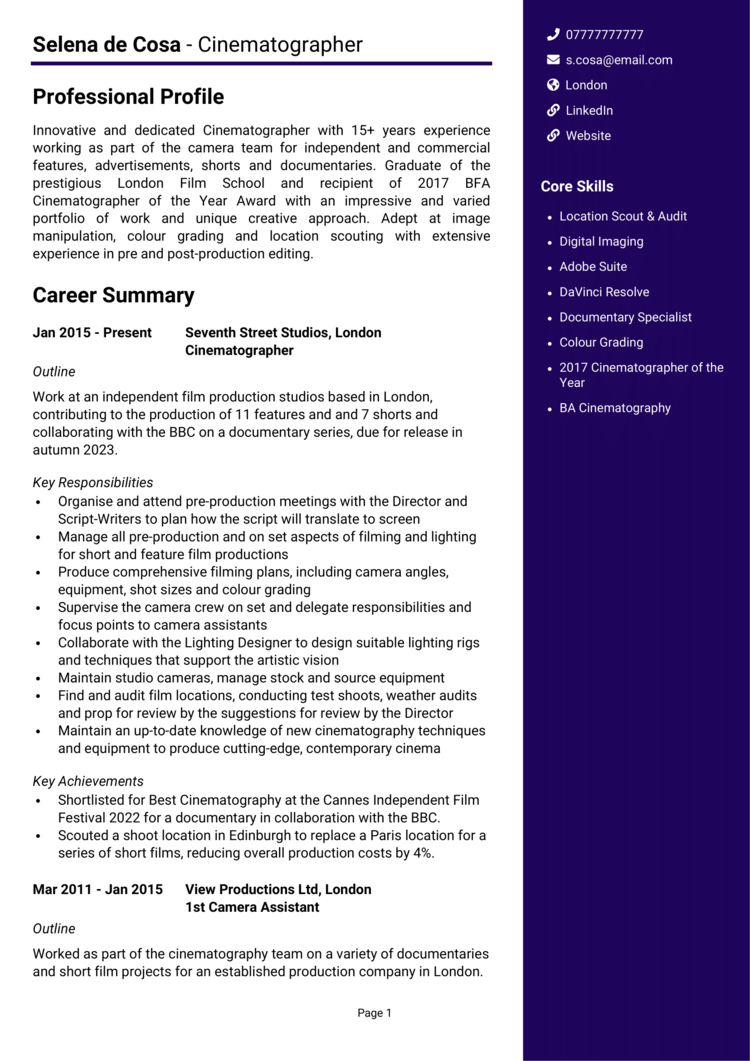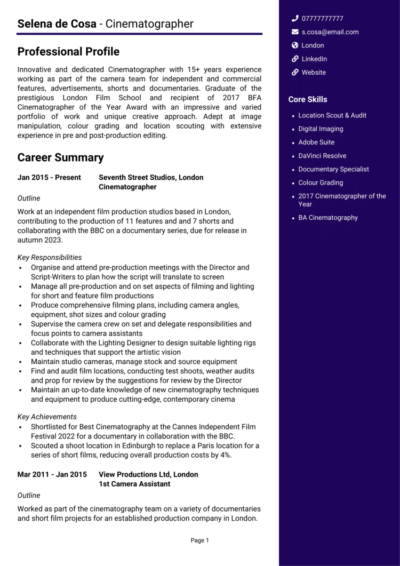You’ve got a sixth sense for visual storytelling – but that won’t land your next job if your CV fades to black before the recruiter gets to page two.
In an industry where creativity and tight deadlines are the norm, your CV has to be more than a list of equipment and titles. With the help of this guide – and a Cinematographer example CV – you’ll learn how to build a standout application that gets you shortlisted, not shelved.
Cinematographer CV

How to write your Cinematographer CV
Discover how to craft a winning Cinematographer CV that lands interviews with this simple step-by-step guide.
Cinematography is about what the audience sees – your CV is about what the industry sees. It should prove you can bring a director’s vision to life and make a production look as good on screen as it does on paper.
This guide will take you through the essentials of writing a CV: from structuring it to presenting your experience in a way that captures attention just as much as your reel.
How to structure and format your Cinematographer CV


A CV structure should be as polished and deliberate as a final cut – if it’s messy, hard to follow, or all over the place, the rest of your talent might be overlooked. A clean layout helps potential employers and production managers quickly spot the skills, experience, and credits that matter most.
Here’s the layout to follow:
- Name and contact details – Keep your name and personal details front and centre at the top. Whether or not to include a photo is your decision.
- Profile – Start with a snapshot of your skills, career highlights, and professional aspirations.
- Core skills – Focus on core skills like making it easy for employers to see your key strengths at a glance.
- Work experience – Walk through your professional experience, beginning with your latest position and moving backwards.
- Education – Highlight your academic achievements, such as degrees and certifications, that demonstrate your expertise.
- Additional info –This section is optional, but it’s a good place for hobbies or interests that complement your CV.
Keep your formatting consistent: use bold headers to separate sections and clean fonts to maintain readability. Limit your CV length to two pages, break down text using bullet points for clarity, and avoid spelling and grammatical mistakes. White space matters here – not just in your shots, but in your layout. The goal? A CV format that communicates precision and clarity before anyone even presses play on your showreel.
How to write a Cinematographer CV profile


Think of this as your opening scene – the moment where you establish tone and direction. Your CV profile should capture the style and substance of your work while highlighting your reliability and technical skills.
Whether you’ve worked with natural light in docuseries or controlled every shadow in commercial shoots, use this space to set the scene for your CV. Make sure it reflects your creative vision, your collaboration with directors and DPs, and the kind of productions you thrive on.
Cinematographer CV profile examples
Profile 1
Experienced Cinematographer with over ten years of experience working on independent films, branded content, and music videos. Skilled in lighting design, camera operation, and visual storytelling across various formats. Proficient with ARRI, RED, and Sony camera systems and known for crafting cinematic visuals that align with directorial vision.
Profile 2
Creative Cinematographer with seven years of experience in commercial production and short-form storytelling. Adept at planning shot composition, directing camera crews, and collaborating with directors and set designers. Strong technical knowledge of digital workflows, colour grading, and on-set lighting techniques.
Profile 3
Versatile Cinematographer with five years of experience across narrative film, live events, and documentary projects. Confident working independently or with full crews, managing equipment, and adapting visual styles to suit different genres and budgets. Experienced with Blackmagic and Canon cinema cameras and fluent in DaVinci Resolve.
Details to put in your Cinematographer CV profile
To shape a compelling profile, include:
- Where you worked – Indie features, branded content, TV dramas, streaming platforms, or music videos
- Your top qualifications – Film production degrees, camera operator certifications, lighting courses
- Essential skills – Composition, lighting, camera operation, working with gaffers and grips
- Types of shoots – Studio, location, handheld, multi-cam, or aerial
- Notable collaborators or gear – Directors, DPs, Red, Arri, Sony, Blackmagic, gimbals or drones
What to include in the core skills section of your CV


This section offers a compact overview of your most valuable cinematography skills.
List off things like your experience with different camera systems and formats, your ability to shape a visual style in line with a director’s vision, and your knowledge of lighting setups for mood and story. If you’ve handled both creative and logistical challenges, make that versatility clear here: your list of skills should immediately assure recruiters that you know what you’re doing.
What are the most important skills for a Cinematographer CV?
- Camera Operation and Framing – Operating cameras and selecting shot composition to visually tell the story with precision and intent.
- Lighting Design and Execution – Designing and implementing lighting setups to create mood, depth, and visual focus for each scene.
- Lens and Equipment Selection – Choosing appropriate lenses, cameras, rigs, and accessories to achieve the desired cinematic effect.
- Shot Planning and Storyboarding – Collaborating on shot lists and storyboards to plan visual sequences in line with the director’s vision.
- Colour Theory and Visual Style – Applying knowledge of colour palettes, tone, and contrast to enhance storytelling and emotional impact.
- On-Set Leadership and Direction – Leading the camera and lighting teams to coordinate technical execution during production.
- Motion and Camera Movement – Using dollies, cranes, gimbals, and handheld techniques to create dynamic and fluid motion in shots.
- Exposure and Focus Control – Adjusting aperture, shutter speed, and focus to ensure visual clarity and stylistic consistency.
- Collaboration with Directors and Departments – Working closely with directors, production designers, and gaffers to align the visual approach.
- Post-Production Visual Continuity – Ensuring consistent lighting and exposure across scenes to support colour grading and editing processes.
How to write a strong work experience section for your CV


This is where your credits come to life. Recruiters and producers want to see not just what you worked on, but what you contributed and how you delivered under pressure.
Walk through your projects in reverse chronological order, including freelance roles, contracts, and longer-term gigs. Each role should start with a short overview of the project or employer, followed by bullet points that describe your responsibilities and standout achievements.
Your work experience should demonstrate your impact, and convey how you’ll continue your track record at a new company.
The best way to structure job entries on your CV

- Outline – Describe the nature of the production, the genre or client, and your role in the crew. Mention who you reported to – DP, director, or production manager.
- Responsibilities – Use action words like “shot” and “orchestrated.” For example: “shot multi-location branded content using RED Komodo with natural light setups” or “orchestrated lighting plans and operated camera for docuseries under tight turnaround.” Include planning, collaboration, and technical decisions.
- Achievements – Highlight anything measurable or notable: a film’s festival success, delivery ahead of schedule, creative praise, or smooth handling of last-minute changes. Add specifics if your work improved visual continuity or elevated production quality.
Sample jobs for Cinematographers
Cinematographer | Clearhall Productions Ltd
Outline
Led cinematography for a series of short films and branded video content at an independent production company, collaborating closely with directors and producers to achieve consistent visual tone.
Responsibilities
- Planned and executed shot lists, camera movements, and lighting setups
- Operated ARRI Alexa Mini and RED cameras on multi-day shoots
- Worked with gaffers and grips to coordinate lighting and rigging
- Oversaw data management and liaised with editors on colour and LUT application
- Scouted locations and advised on visual feasibility during pre-production
Achievements
- Shortlisted for Best Cinematography at the 2023 Indie Visuals Awards
- Helped increase client satisfaction scores by 35% through enhanced visual consistency
- Built a network of freelance crew, reducing sourcing time for new projects by 40%
Cinematographer | Crescent House Media
Outline
Provided cinematography for commercial campaigns, interviews, and social media content for clients in retail, tech, and hospitality sectors at a mid-sized creative agency.
Responsibilities
- Designed lighting and visual setups to meet brand and project requirements
- Used Sony FX6 and Blackmagic URSA Mini Pro to shoot on location and in studio
- Supervised multi-camera setups and ensured continuity across scenes
- Adjusted framing, lens selection, and camera settings based on director feedback
- Managed gear logistics, backups, and location prep
Achievements
- Contributed to a campaign that increased a retail client’s video engagement by 55%
- Improved on-set efficiency by creating a reusable lighting setup guide for shoots
- Recognised internally for adaptability across different client styles and formats
Cinematographer | Freelance
Outline
Worked as a freelance DOP on a variety of independent documentaries, music videos, and promotional content for creative teams and small businesses across the UK.
Responsibilities
- Collaborated with directors and producers to define visual concepts and references
- Shot handheld and gimbal-based footage using Canon C70 and DJI Ronin gear
- Balanced technical camera work with creative input across different genres
- Handled post-production handovers and colour-matching references
- Booked locations and managed small crew hires when required
Achievements
- Delivered 20+ projects for independent musicians and content creators in 18 months
- Received over 100,000 YouTube views on a music video shot for a local artist
- Built repeat client base through consistent creative output and project reliability
How to list your educational history


While practical experience often speaks louder than qualifications in creative roles, your education section still helps to show your technical grounding and commitment to the craft.
List your degrees or training courses in reverse order, beginning with the most recent. Short courses, workshops, or certifications (e.g. Steadicam, drone operation, or health and safety for shoots) can also be listed here. Keep this section pretty brief, as experience is always the priority.
What are the best qualifications for a Cinematographer CV?
- BA (Hons) in Film Production or Cinematography – Offers hands-on training in shooting, lighting, and editing
- Diploma in Camera and Lighting for Film and TV (NFTS or equivalent) – Focused industry training with equipment and crew experience
- Arri Camera Systems Certification – Ideal for professionals working on high-end commercial or narrative content
- Drone Operator Certification (CAA PfCO / GVC) – Required for aerial shots in UK-based shoots
- Lighting for Cinematography Short Courses – Practical training in shaping light for mood and clarity





